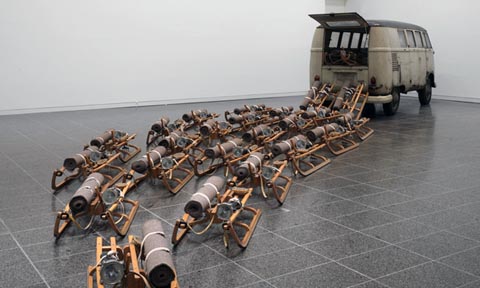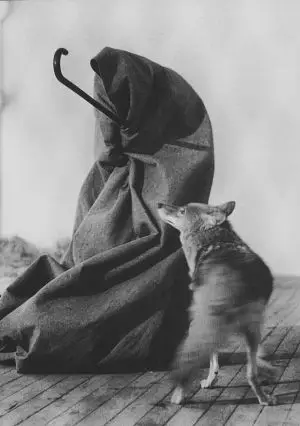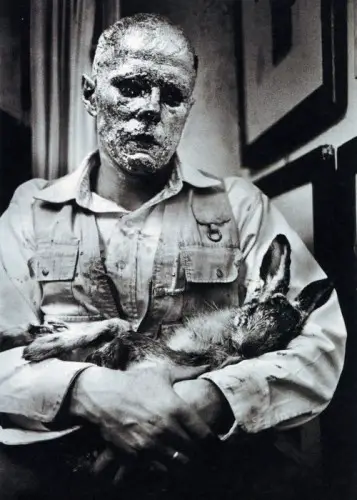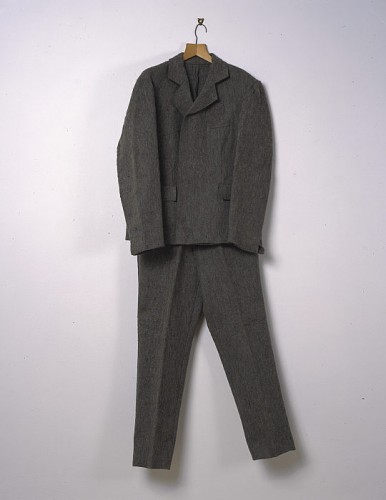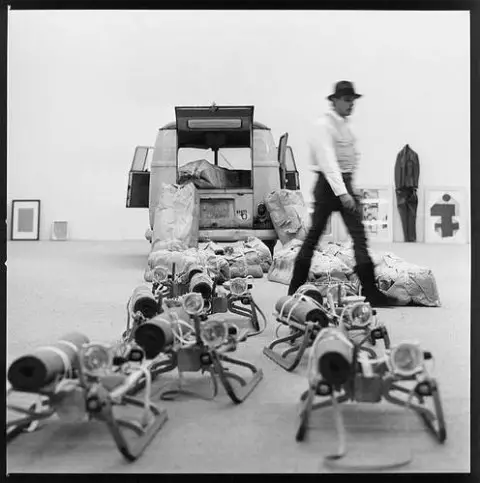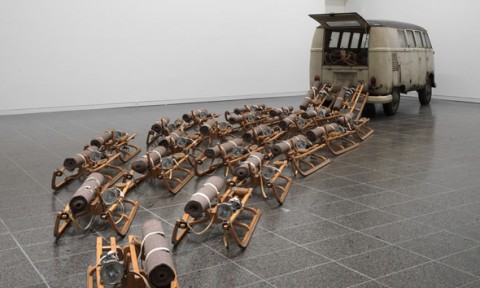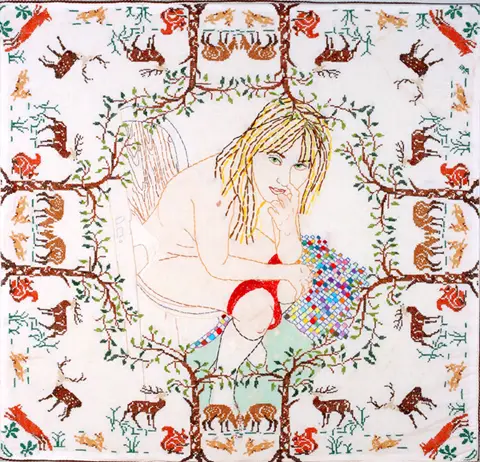Note: This post was originally published in 2011.
Hi Everybody! This week, my sweet husband and Manbroidery founder, Johnny Murder is celebrating his 40th birthday! YAY! I love you Papa! In honor of him and Manbroiderers the world over, I’ve decided to write about Joseph Beuys.
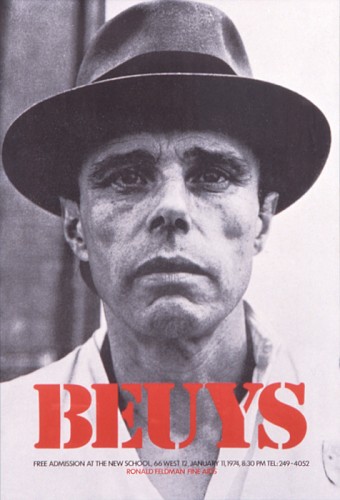 German artist Joseph Beuys (May 12th, 1921 – January 23, 1986)
German artist Joseph Beuys (May 12th, 1921 – January 23, 1986)
From Joseph Beuys The Reader, “During his lifetime, he was simultaneously celebrated and lampooned by by fellow artists and by the international art community; since his death he has been lauded as heroic by some and condemned by others as a dark figure of German fascism and totalitarian impulses.” From Wikipedia, “Joseph Beuys was a German performance artist, sculptor, installation artist, graphic artist, art theorist and pedagogue of art. His extensive work is grounded in concepts of humanism, social philosophy and anthroposophy; it culminates in his ‘extended definition of art’ and the idea of social sculpture as a gesamtkunstwerk, for which he claimed a creative, participatory role in shaping society and politics. His career was characterized by passionate, even acrimonious public debate, but he is now regarded as one of the most influential artists of the 20th century.”
Now I have a headache. Let’s try this again.
Once, Beuys traveled to the U.S, and when he arrived, he was picked up by an ambulance and taken to the Rene Block Gallery where he was wrapped in felt and carried in by a stretcher. Then he spent the next 3 days, 8 hours a day, locked in the room with a feral coyote.
Also, he planted 7000 oak trees around the city of Kassel, each tree was set next to a basalt stone. He took a piano and covered it in felt. He was shot down on the Crimean front, and rescued by Tartars who kept him alive by covering his body with fat and wrapping him with felt. One time, he covered his face with honey and gold leaf, and carried around a dead rabbit and tried to explain art to it.
Only one of these stories isn’t true.
Beuys was a pioneer, not only in his work but in his personal mythology. In a time when Germany was turning away from nationalism and pivoting towards focusing on the individual, Beuys made a shift from citizen and soldier, to what may best be described as the artist as a shaman. It is not only his use of felt and stitching that I think qualifies him as a Manbroiderer, but also what was essentially his mission statement. Taken from the Walker Art Center website– “One of Joseph Beuys’ fundamental messages, delivered again and again in lectures, interviews, and artworks, was that human beings can and must learn to be creative in many different ways. His famous slogan “Everyone is an artist” was not meant to suggest that all people should or could be creators of traditional artworks. Rather, he meant that we should not see creativity as the special realm of artists, but that everyone should apply creative thinking in their own area of specialization–whether it be law, agriculture, physics, education, homemaking, or the fine arts.”
Beuys’ use of felt prominently reflects his origin story as well his fixation on warmth.
Excerpts from an interview with the artist by Jorg Schellmann and Bernd Kluser, 1970
“K: Why doesn’t the Felt Suit have buttons?
“B: Well, that was dictated by the character of felt. That occurred quite naturally. It was tailored after my own suit and I think the whole thing has to retain the character of felt, in the sense that felt doesn’t strive to be smart, so to speak. One has to conserve the character, omit mere trifles, such as complicated buttons, buttonholes and so on, and if somebody wants to wear the suit, he can fasten it with safetypins.
“S, K: Does the association with convicts’ uniforms on which the buttons and braces have been cut off as a sign of disgrace apply?
“B: Of course I thought of that, but there’s no direct relation. It isn’t meant to be a suit which people wear. The suit is meant to be an object which one is precisely not supposed to wear. One can wear it, but in a relatively short time it’ll lose its shape because felt is not a material which holds a form. Felt isn’t woven. It’s pressed together usually from hare or rabbit hair. It’s precisely that, and it isn’t suited for buttonholes and the like.
“S, K: How should one take care of the Felt Suit?
“B: I don’t care. You can nail the suit to the wall. You can also hang it on a hanger, ad libitum! But can also wear it or throw it into a chest.
“S, K: Does the suit’s felt material play the role of insulating the physical warmth of a person?
“B: The character of warming–yes, that’s obvious. The felt suit is not just a gag. It’s an extension of the felt sculptures I made during my performances. There, felt also appeared as an element of warmth or as an insulator. Felt was used in all the categories of warmth sculpture, usually in connection with fat: And it’s a derivative of that. So it does have a bearing on the character of warmth. Ultimately the concept of warmth goes even further. No even physical warmth, I could just as well have used an infrared light in my performances. Actually I mean a completely different kind of warmth, namely spiritual warmth or the beginning of an evolution.“
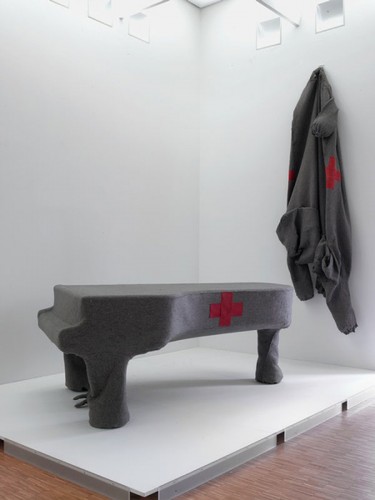 Homogeneous Infiltration for Piano 1966, and The Skin 1984
Homogeneous Infiltration for Piano 1966, and The Skin 1984
“The sound of the piano is trapped inside the felt skin. In a normal sense, a piano is an instrument used to produce sound. When not in use, it is silent, but still has sound potential. Here, no sound is possible, and the piano is condemned to silence. The relationship to the human condition is marked by the two red crosses, signifying emergency. The danger that threatens, if we stay silent and fail to make the next evolutionary step. Such an object is intended for a stimulus in discussion, and in no way is it intended to be taken as an aesthetic product. It is vital that humankind should slowly learn to speak, should come out of its dampness, and this applies above all, to the man in the street.” – Joseph Beuys
Description from The Tate Modern- “Beuys commented: ‘This is an emergency object: an invasion by the pack. In a state of emergency the Volkswagen bus is of limited usefulness, and more direct and primitive means must be taken to ensure survival.’ This strongly autobiographical work refers directly to Beuys’ plane crash over the Crimea during the Second World War. He often described being rescued by a band of Tartars who coated his body with fat and wrapped him in felt. Whether real or mythical, the story shows the symbolic importance of these materials in Beuys’ mind. It also suggests a fable of death and rebirth in which Beuys is purged, perhaps of his wartime guilt, and brought back to life by a nomadic people.”
As fiber artists, or crafters, or stitchers, or all three, I think it’s important to look back and really explore the artists who came before us. I think we often times forget that there is a tradition of fiber work in fine art, and studying that can open us up to wonder and revelations. It can help push us forward to break boundaries, and gives us a bigger space to grow.
I think Beuys puts it pretty well when he says, “Art alone makes life possible “ this is how radically I should like to formulate it. I would say that without art man is inconceivable in physiological terms…I would say man does not consist only of chemical processes, but also of metaphysical occurrences. The provocateur of the chemical processes is located outside the world. Man is only truly alive when he realizes he is a creative, artistic being…Even the act of peeling a potato can be a work of art if it is a conscious act.“
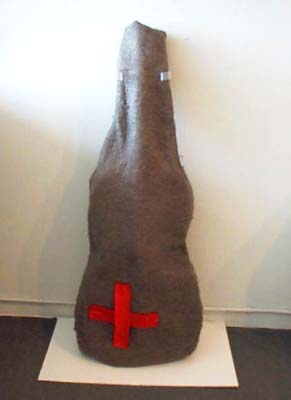 Homogeneous Infiltration for Cello, 1967
Homogeneous Infiltration for Cello, 1967
—————-
Penny Nickels is a printmaker that started playing with needles with tremendous effect. She and her husband, Johnny Murder, have been described as the “Bonnie and Clyde of Contemporary Embroidery” and you can discover the power of her creativity at her blog.
—————-
All reference material is cited in the above text. Click highlighted portions for more information.

